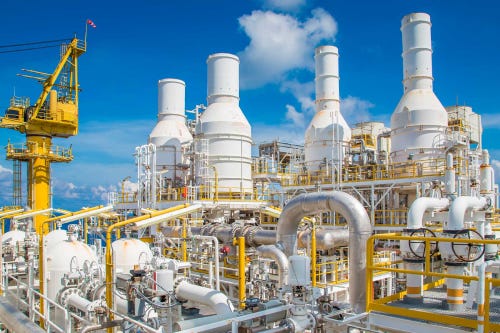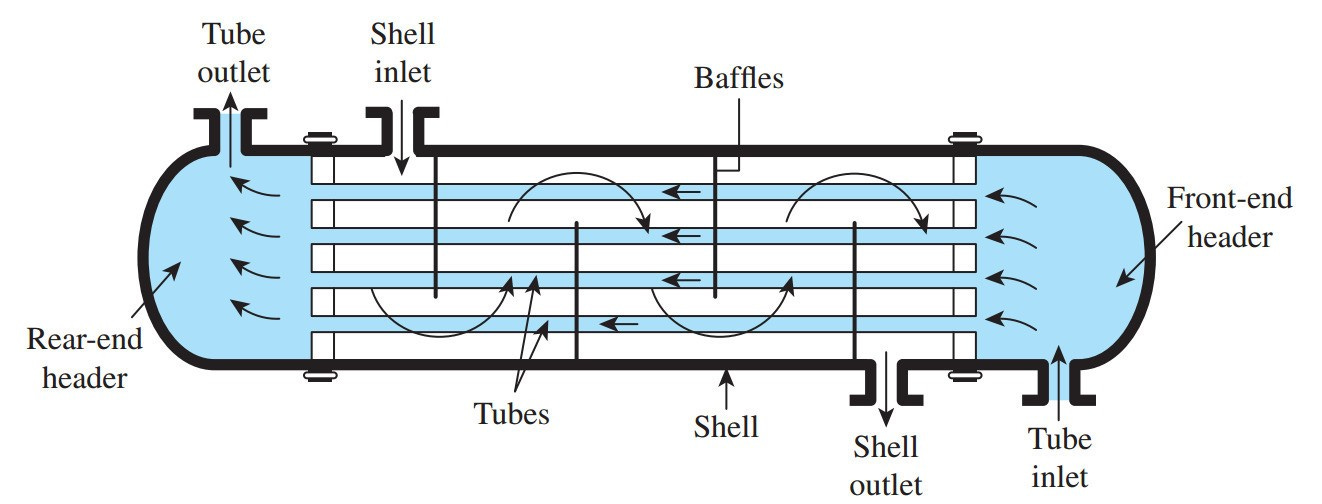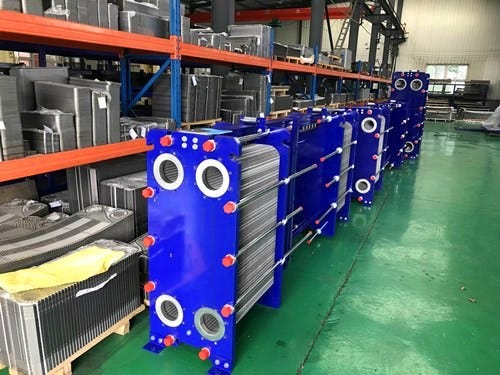Comprehensive Overview of Heat Exchangers in Petroleum Refineries
Discover how heat exchangers work in petroleum refineries, the different types used, and their vital roles in improving efficiency, process safety, and energy recovery
The Role of Heat Exchangers in Petroleum Refineries
Heat exchangers play a pivotal role in petroleum refineries, where managing and optimizing temperature is crucial for efficient operations. Whether it’s for heating, cooling, or recovering heat, these devices contribute significantly to maintaining safe and cost-effective refinery processes. Without them, refineries would experience a substantial loss of energy, increased operational costs, and heightened safety risks. In this article, I will cover the concept of heat exchangers, the different types employed in refinery operations, and their specific applications.
What is a Heat Exchanger?
A heat exchanger is a piece of equipment designed to transfer heat between two or more fluids without allowing them to mix. These fluids are typically at different temperatures, and the exchanger’s job is to facilitate the efficient transfer of thermal energy from the hotter fluid to the cooler one. The key feature of a heat exchanger is that it accomplishes this heat transfer without direct contact between the fluids, which would risk contamination or chemical reaction.
Why are Heat Exchangers Crucial in Refineries?
In the highly complex and energy-intensive environment of a refinery, heat exchangers are critical in maintaining the desired temperatures for various processes. Their primary benefit is energy conservation by recovering heat from hot process streams and redirecting it to areas that require heating. This not only improves the overall energy efficiency of the refinery but also reduces fuel consumption and operating costs. Furthermore, effective heat management ensures that processes remain within safe temperature limits, preventing overheating and potential equipment failures.
Types of Heat Exchangers Used in Petroleum Refineries
In a refinery, heat exchangers come in several forms, each designed for specific process conditions and thermal requirements. Understanding these types and their functions is essential for ensuring optimal performance and longevity.
1. Shell and Tube Heat Exchangers
This is the most widely used type of heat exchanger in petroleum refineries due to its versatility, reliability, and robustness in handling high-pressure applications. A shell and tube exchanger consists of a cylindrical shell surrounding a bundle of tubes. One fluid flows through the tubes (tube-side fluid), while another fluid flows over the tubes within the shell (shell-side fluid), allowing heat transfer between the two.
Subtypes:
Floating Head Exchangers: These are designed to allow one end of the tube bundle to "float" or move, accommodating the thermal expansion that occurs during temperature changes. This flexibility makes floating head exchangers ideal for processes where there are significant temperature differences between the fluids.
Fixed Tube Sheet Exchangers: Fixed tube sheet exchangers have both ends of the tube bundle rigidly attached to the shell. While simpler and less expensive than floating head designs, they cannot handle large temperature differentials as well. They are best suited for services with clean fluids that require minimal maintenance.
U-Tube Exchangers: U-tube exchangers are characterized by their tubes being bent into a U-shape, which allows for greater thermal flexibility. The U-shaped tubes are easier to clean on the shell side, but their internal cleaning can be more challenging compared to straight-tube designs.
2. Air Fin Fan Coolers
Air-cooled heat exchangers, often referred to as air-fin fan coolers, are essential in regions where water is scarce or where environmental regulations limit water use. These exchangers consist of finned tubes over which air is blown using large fans. Air coolers are commonly used to condense process vapors or cool hot liquids. Unlike water-cooled exchangers, air fin fan coolers rely on ambient air for cooling, making them an energy-efficient solution in arid environments.
Advantages:
Water Conservation: Since they use air instead of water, these coolers are particularly valuable in areas with limited water resources.
Reduced Operational Costs: With no need for water treatment, the operational expenses associated with air coolers are generally lower.
3. Plate Heat Exchangers
Plate heat exchangers consist of thin, corrugated metal plates stacked together. The fluids flow through alternating channels between the plates. This design allows for highly efficient heat transfer due to the large surface area provided by the plates.
Applications in Refineries: Plate heat exchangers are used when space is limited and when highly efficient heat transfer is required. However, they are more prone to fouling compared to shell and tube exchangers, making them less suitable for handling dirty or viscous fluids. Their compact design makes them ideal for smaller-scale operations or specific processes where frequent cleaning is possible.
4. Reboilers and Kettle-Type Heat Exchangers
Reboilers are specialized heat exchangers used in distillation columns, which are a core part of refinery operations. They provide heat to the bottom of the distillation column to vaporize the liquid for separation. Kettle-type reboilers are designed with a large vapor space, which allows the liquid to boil and generate the necessary vapors without excessive pressure buildup.
Key Features:
Large Vapor Space: This design reduces pressure drop and allows the reboiler to handle fluctuating loads, which is critical in distillation processes.
Versatility: Kettle reboilers can be used in various distillation applications, including crude oil fractionation and gas processing.
5. Waste Heat Recovery Boilers
Waste heat recovery boilers are used to capture excess heat from refinery processes, such as flue gases, and convert it into steam. This steam can be used in power generation or in driving turbines within the refinery.
Benefits:
Energy Efficiency: By recovering and reusing waste heat, these exchangers significantly reduce the need for external fuel sources.
Environmental Impact: Waste heat recovery contributes to lower greenhouse gas emissions by reducing the overall energy consumption of the refinery.
Key Functions of Heat Exchangers in Refineries
Heat exchangers perform several vital functions that contribute to the overall efficiency and safety of petroleum refining processes.
Distillation: In the distillation of crude oil, heat exchangers play a critical role in heating the incoming crude feed and condensing the vapors produced during fractionation. This ensures that the distillation process operates efficiently and at the required temperature gradients.
Cooling Process Streams: After various refining processes, product streams need to be cooled before further processing or storage. Heat exchangers efficiently reduce the temperature of these streams by transferring heat to other parts of the process or using cooling fluids like water or air.
Preheating Feeds: In refineries, heat from one process stream is often reused to preheat another stream. For example, heat exchangers can use the heat from outgoing hot gases to preheat incoming cold liquids, thus reducing the energy needed to bring these liquids up to processing temperature.
Steam Generation: Waste heat boilers generate steam by capturing heat from flue gases and other high-temperature sources. This steam can then be used in turbine generators or to drive other mechanical equipment within the refinery.
Technical Applications in Refineries
1. Distillation Columns
Distillation is one of the most critical processes in petroleum refining, used to separate the various components of crude oil based on their boiling points. Heat exchangers, particularly reboilers, ensure that the required heat is supplied to the bottom of the column, facilitating the vaporization of the liquid feed.
Reboilers in Action: As the hot liquid rises through the distillation column, it separates into its components, which are then collected at various points along the column. Heat exchangers maintain the precise temperature needed for effective separation.
2. Catalytic Cracking
Catalytic cracking is a refining process where heavy hydrocarbons are broken down into lighter, more valuable products like gasoline. This process operates at high temperatures, and heat exchangers help in recovering heat from process gases, which are reused in other areas of the refinery.
Energy Efficiency: The use of heat exchangers in catalytic cracking reduces the need for additional fuel, thereby improving the refinery's energy efficiency and lowering operating costs.
3. Hydrogen Processing
During hydrogen processing, gases and liquids are cooled at various stages, and heat exchangers play a crucial role in managing these temperature changes. Maintaining the correct temperature ensures the hydrogen produced is of the highest purity and effectiveness.
4. Waste Heat Recovery
Refineries produce large amounts of waste heat during combustion and other high-temperature processes. Heat exchangers used in waste heat recovery systems capture this heat and repurpose it, making refineries more energy-efficient.
Advantages of Using Heat Exchangers in Petroleum Refineries
Energy Efficiency: Heat exchangers optimize the use of energy by recovering heat that would otherwise be lost. This reduces fuel consumption and lowers operating costs.
Environmental Benefits: By improving energy efficiency, heat exchangers help refineries lower their carbon emissions, making operations more sustainable.
Process Safety: Heat exchangers maintain stable temperatures, preventing overheating and reducing the risk of equipment failure or hazardous conditions.
Cost Savings: The efficient use of heat reduces the refinery’s overall energy costs, contributing to improved profitability.
Challenges in Heat Exchanger Operations
1. Fouling
Fouling occurs when impurities or solid particles in the fluids deposit on the heat transfer surfaces, reducing the efficiency of the exchanger. Fouling can cause increased pressure drops, reduced heat transfer efficiency, and higher operational costs due to frequent cleaning.
2. Corrosion
Corrosion is a common issue in refineries where fluids contain corrosive agents like sulfur compounds or chlorides. Corrosion can lead to the weakening of heat exchanger components, necessitating repairs or replacements and causing unplanned downtime.
3. Thermal Fatigue
Heat exchangers experience significant temperature variations during operations. This repeated thermal cycling can cause stress in the materials, leading to cracks and mechanical failures, especially in exchangers that are not designed to handle such fluctuations.
Maintenance and Inspection of Heat Exchangers in Refineries
1. Regular Cleaning
Routine cleaning of heat exchangers is essential to prevent fouling. Hydroblasting and chemical cleaning help maintain the exchanger’s efficiency and extend its service life.
2. Corrosion Mitigation
Refineries use corrosion-resistant materials like stainless steel and install sacrificial anodes to prevent corrosion. Regular inspections help identify early signs of corrosion, allowing for timely maintenance or replacement.
3. Thermal Monitoring
Monitoring temperature differentials helps detect potential issues related to thermal stress. Proactive maintenance strategies based on temperature monitoring can extend the life of heat exchangers and improve overall refinery efficiency.
The Importance of Heat Exchangers in Refinery Efficiency
Heat exchangers are critical to refinery operations, playing a key role in energy recovery, process efficiency, and operational safety. By maintaining optimal temperatures and reducing energy consumption, heat exchangers ensure that refineries operate smoothly, safely, and cost-effectively.
To stay updated on the latest insights into heat exchanger maintenance and energy efficiency strategies, subscribe to our newsletter today. Learn how to optimize your refinery operations and reduce operational costs.





